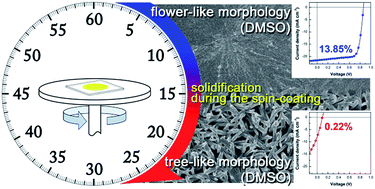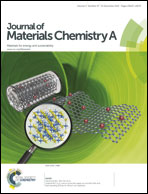Two different mechanisms of CH3NH3PbI3 film formation in one-step deposition and its effect on photovoltaic properties of OPV-type perovskite solar cells†
Abstract
Although the one-step deposition method has intensively been studied because of the simple and easy fabrication of perovskite films, uncontrolled crystallization of perovskite during one-step deposition often results in films with small crystallites and low surface coverage, leading to low photovoltaic performance. In this study, we have proposed the optimum processing conditions to afford a favorable crystal morphology of perovskite films for achieving high power conversion efficiency of perovskite solar cells. Two different morphologies, tree-like and flower-like morphologies, are developed depending upon the spin-coating time and post-heat treatment temperature. When the perovskite is crystallized from the liquid film after a short spin-coating time, the flower-like morphology is developed, whereas the tree-like morphology is developed when the perovskite is crystallized for a long spin-coating time. When the morphology evolution is monitored using in situ optical microscopy and X-ray diffraction to investigate the origin of the difference between tree-like and flower-like morphologies, it reveals that the CH3NH3I–PbI2–solvent complex is formed to develop the tree-like morphology before CH3NH3PbI3 crystals are formed, whereas the flower-like morphology is developed when the CH3NH3PbI3 crystals are formed directly from the liquid film without the formation of the CH3NH3I–PbI2–solvent complex. The film with a flower-like morphology, as prepared from DMSO solution, has large-sized crystallites, and the crystallites are highly orientated along (112) and (200) directions, resulting in a high PCE of 13.85%, whereas the film with a tree-like morphology has small-sized crystallites with random crystal orientation, exhibiting very low PCEs.


 Please wait while we load your content...
Please wait while we load your content...